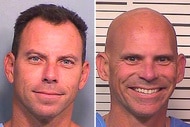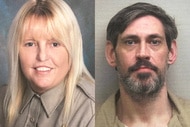Create a free profile to get unlimited access to exclusive videos, breaking news, sweepstakes, and more!
Man Convicted In 1989 Murder Of Stepbrother Could See New Trial As Unearthed Evidence Spurs Questions
John Tiedjen says he doesn't remember the night his stepbrother Brian McGary died. He's hoping newly surfaced crime scene photos and police reports will cast doubt on his conviction.

Questions are being raised in an Ohio man’s 1989 murder conviction for the shooting death of his stepbrother. For more than three decades, John Tiedjen, 57, has maintained that he could not remember what happened the night of his stepbrother’s death and that police forced him to confess. Now, Cuyahoga County Judge Dick Ambrose is considering whether or not a convicted man deserves a new trial.
“To this day, the complete investigation has never been made available to the defense,” said Tiedjen’s defense attorney, Kimberly Corral, according to Cleveland.com.
The defense submitted 77 new crime scene photos in addition to 10 images submitted by prosecutors during the 1989 trial. They also argued at the hearing that prosecutors failed to provide amended police reports, which, according to Corral, proved that investigators contaminated the crime scene.
On the night of April 1, 1989, John Triedjen and his stepbrother Brian McGary,18, returned to the duplex they shared in Cleveland’s Slavic Village neighborhood after a night of heavy drinking and smoking marijuana, according to Cleveland.com. A neighbor near the East 87th St. home reported seeing Triedjen leaving shortly after the sound of a gunshot. Triedjen went to the neighbor’s home the following morning and said that he found McGary dead. He believed it was a suicide.
Authorities found McGary curled up near the foot of his bed with a one-inch stab wound to the chest and a bullet wound from a .22-caliber rifle directly between the eyes. A knife in a pool of blood remained on McGary’s bed, and the rifle was lying across his feet, according to Cleveland.com.
Now, new crime scene photos, along with the previous police reports that were never entered in as evidence in the original trial, have been submitted to Judge Ambrose.
“The notion that we could conclude that a conviction based on 77 hidden photos and 32 pages of hidden police reports is a conviction that can stand in the system of America jurisprudence system is a notion that defies the fundamental concepts of the constitutional integrity of our system,” Corral said during the hearing, according to Cleveland.com. “Every aspect of the case that the state relied on to get a conviction has been undermined by the evidence they withheld, that has now been revealed by Mr. Tiedjen.”
Judge Ambrose saw two sets of photos: one from the original crime scene and a set of photographs taken five days later, which showed that someone moved items.
An example included a pair of Tiedjen’s eyeglasses photographed on a coffee table in the first set of photos, while the second set showed the same pair of glasses near the pool of blood by McGary’s body.
According to the supplemental police reports submitted by the defense, police allowed McGary’s ex-girlfriend to enter the crime scene several days after McGary’s death, when she called and asked to retrieve her purse. Police permitted her to do so, but there is no record of police escorting her onto or off the crime scene. There were also no records of police ever interviewing her.
New photos show the ex-girlfriend’s purse, a woman’s vest, and an unknown man’s jacket, items that the court never saw in the original murder trial.
The jacket’s owner is still unaccounted for. Tiedjen’s attorneys have put forth a theory that a man and a woman might have been present during the shooting and left in a rush, a notion that may be supported by a 2002 statement from a witness who stated that after hearing the gunshot, he saw a man and woman run from the house and jump into a black truck.
John Tiedjen confessed several days after the shooting but had always maintained that the interrogating officer claimed that he’d be facing life in prison with the evidence they had against him, but if he confessed on the spot, he could serve less time for manslaughter.
“Police told me what to say,” John Tiedjen said, according to Cleveland's Fox8 News.
Tiedjen has long claimed that he could not remember the events on account of alcohol and marijuana use.
The new evidence was previously submitted to a judge in 2017, but Common Pleas Court Judge Nancy Russo denied Tiedjen a new trial. Russo stated that the photographs would not have altered the evidence that convicted Triedjen in 1989.
“The idea that the officers were altering crime scenes in order to frame John Tiedjen, and that they were taking pictures of their corruption and then documenting their corruption in a police report, is just absurd,” Assistant Cuyahoga County prosecutor Frank Zeleznikar said, according to Cleveland.com.
However, after the 2017 hearing, the photos were lost, according to the court records.
Defense attorneys now have to rely on black and white copies of the originals.
Upon discovering the photos in 2016, Tiedjen’s defense team presented the photos to expert witness Scott Roder, the owner of a company that specializes in crime scene video reconstruction.
“Some of these photographs don’t nearly come to any level of a complete or comprehensive documentation of this crime scene,” Roder said at the recent hearing. “There is no evidence, physically or forensically, to suggest that John Tiedjen committed murder.”
Roder indicated that he believed McGary committed suicide, and testified that investigators wrapped McGary’s hands in plastic instead of paper, which could have destroyed evidence of gunshot residue. He also discounted the prosecution’s claims that someone shot McGary from a distance.
“The state’s theory was really effective when they had all the evidence hidden,” said Corral.






















